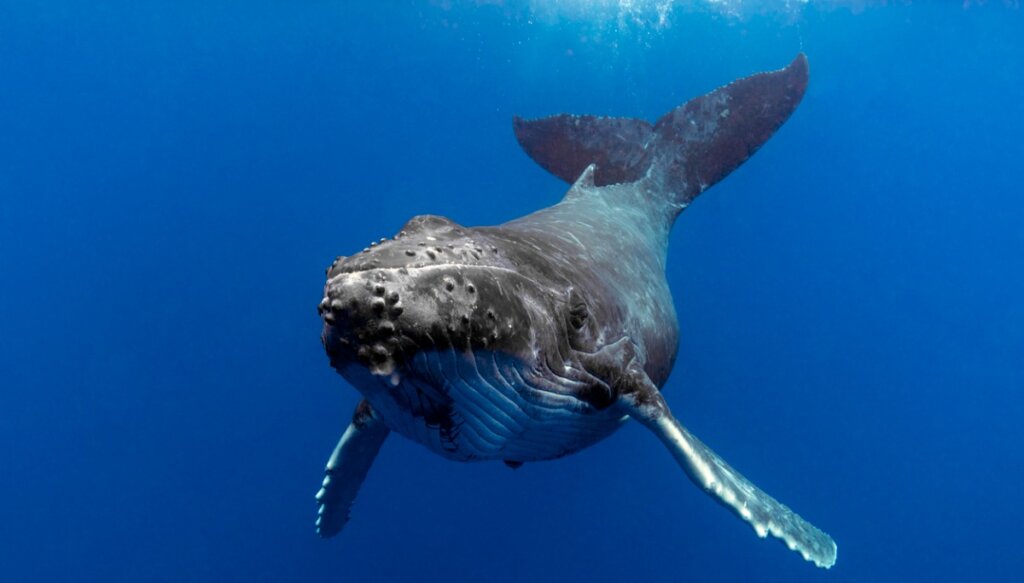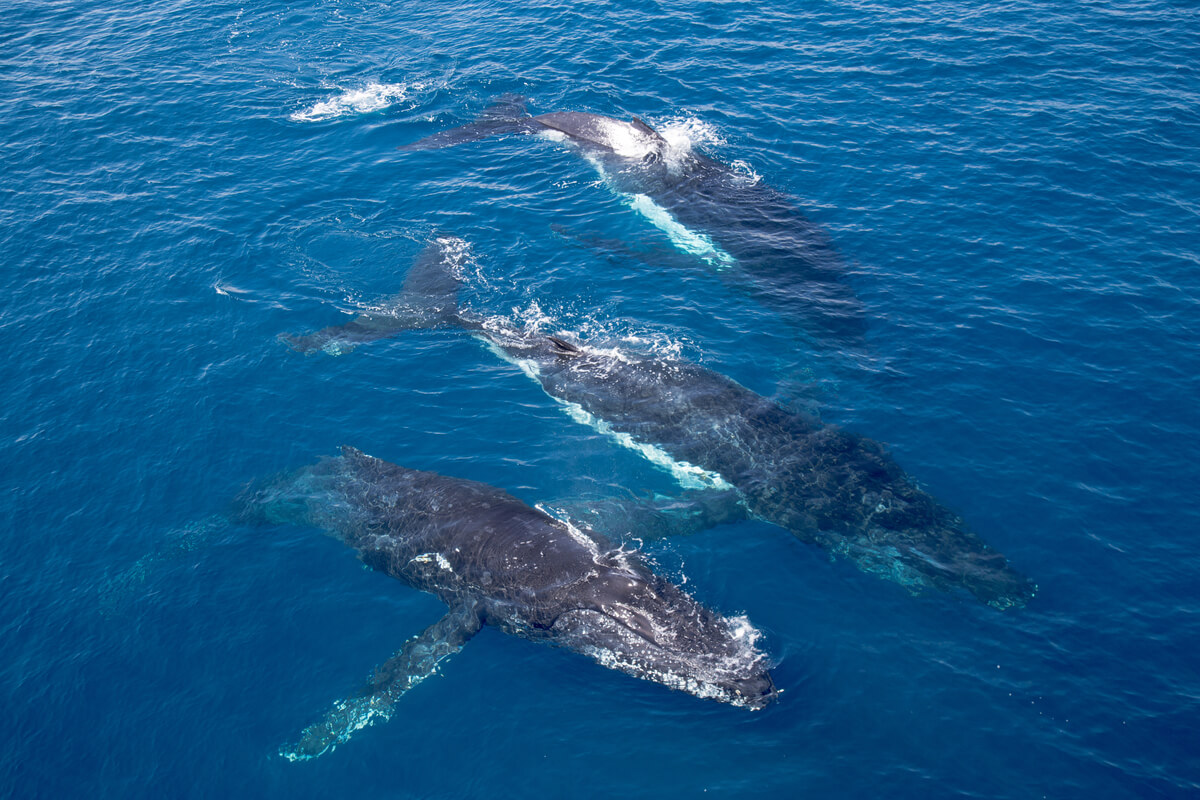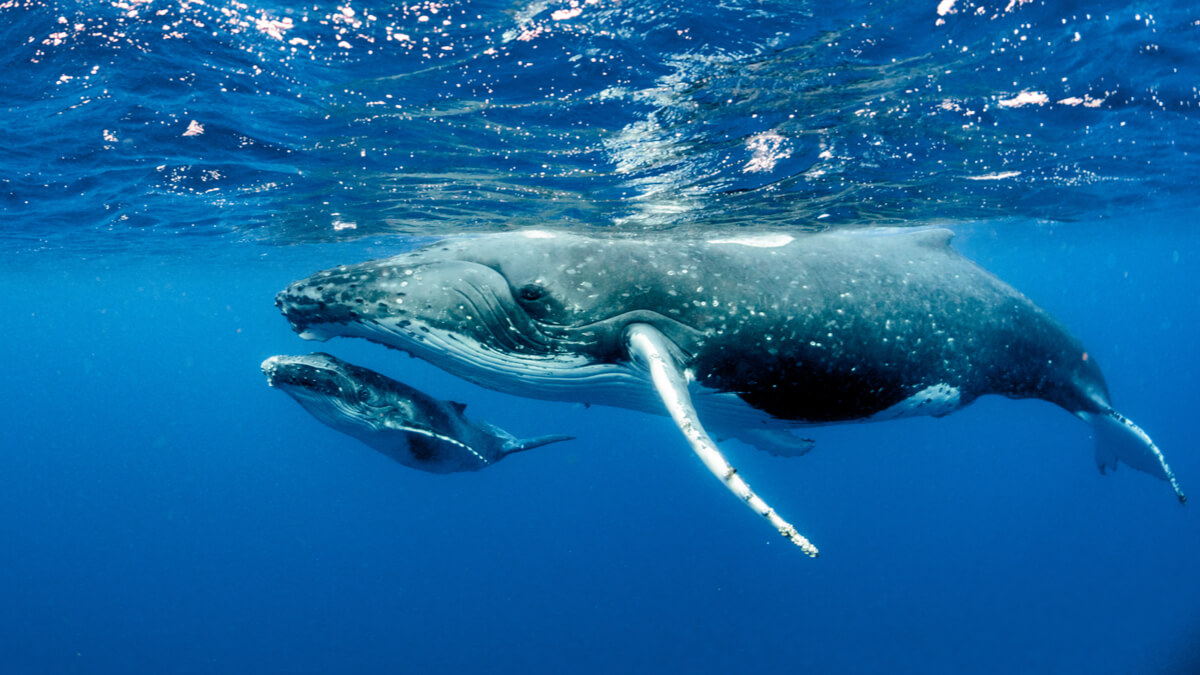All About Whale Behavior

These giants of the sea have starred in tales and legends since humans entered the oceans. It isn’t surprising that they’re part of the collective imagination of society, since whale behavior is so alien and, at the same time, so intuitive that it almost gives a feeling of mysticism.
This is why researchers have spent years and years trying to decipher the minds of cetaceans. Here we bring you the most significant findings about their behavior. We assure you that you’ll want to know more and more after reading them.
Whale characteristics
Whales are marine mammals that belong to the order of cetaceans. Within this order, we find 2 families: odontocetes – cetaceans with teeth, such as killer whales and dolphins – and mysticetes, a group in which the teeth are replaced by filtering beards, in turn formed by keratin fibers.
Be that as it may, these mammals inhabit the length and breadth of all the world’s oceans. They normally migrate in search of warm waters, but some species can be found in colder environments, such as the boreal whale (Balaena mysticetus).
Although they’re placental mammals, whales adapted so they didn’t have to leave the water for their entire lives. Voluntary breathing, unihemispheric sleep, and spiracles are some of the most curious strategies developed by these animals for a completely aquatic existence.
There are 4 subfamilies within the mysticetes, classified according to their characteristics. They’re the following:
- Balenidae: Members of this group lack a dorsal fin and their jaw is more arched compared to other species.
- Balenopteridae or fin whales: Their dorsal fin is in a more dorsal position than in other groups. These whales have furrows in the skin, which run through their ventral part to the pectoral fins.
- Eschrichtiidae: Its only representative is the gray whale (Eschrichtius robustus), which lacks a dorsal fin and has 2 grooves under its mouth.
- Neobalaenidae: This taxon also has a single species, the pygmy right whale (Caperea marginata). It’s similar to members of the Baelenidae subfamily, but is much smaller in size.

Whale communication
The language of cetaceans is very complex and varies between species, individuals and even groups. Vocalizations include ultrasound — also used for echolocation — and audible sounds. However, these animals lack vocal cords and produce sound through the larynx.
All this translates into incredible facts, such as their ability to change the frequency of their messages so that they don’t interfere with those of other whales, oral transmission of knowledge between groups of whales, an ability to call each other, and even the use of syntax in their messages. Even different dialects are observed between different groups of the same species.
Musical language
The songs of whales are especially striking, not only because of their repetitive and melodic character, but because they can be heard from miles away. Normally, these vocalizations can be heard in times of mating and migrations, in which the specimens call each other to find a mate or to locate individuals lost along the way.
The sounds emitted by whales in their songs vary in frequency between 15 and 20 Hertz. They can modulate it based on the distance they want to cover – they use lower frequencies for deep water and higher-pitched sounds for when they’re closer to the surface.
The songs are made up of different phrases that are repeated continuously, although it has been observed that the whales are able to improvise or develop old melodies to more complex ones.
Whale behavior
Whales are social animals that form family groups of up to 12 individuals, but some species are solitary and only found to reproduce or feed. The groups are organized hierarchically based on the sexual competence of the males.
Whales are generally gentle animals that have no predators in their adult life, as their sheer size makes them unattainable by hunters.
Their intelligence, social behavior, and communication are elements that interact with each other. In the case of whales, the absence of predators and their high encephalization quotient – that is, they have a very large brain compared to their body – has allowed them to develop culturally and socially.
Whale behavior in social groups
Mothers create strong bonds with their young and are very protective; they can even adopt orphans. Aunts and grandmothers help with the care of the little ones, transmitting their teachings to new mothers through oral communication and imitation.
Although males and females don’t usually establish relationships beyond reproduction, they coordinate to protect and guide the group to safe waters and with food. Within each group, alliances are established based on emotional ties, but also to move up the scale of power.
Whale behavior during migration
Changes in water temperature and ocean currents lead whales to travel thousands of kilometers in search of food sources and breeding pairs. During these migrations, the groups communicate with each other to indicate the way or point out the places where there are no dangers.
The reproductive cycle also influences the predictability of whale migrations. Females prefer to give birth in warm waters, as low temperatures can be detrimental to young, which haven’t yet developed the layer of fat that protects them.
The longest migration is that of the gray whale (Eschichtius robustus), which travels 20,000 kilometers along the coast of North America.
Behavior in captivity
Captivity has drastic effects on whale behavior. These are self-aware animals that know they’re captive, and so this often causes mental disorders – anxiety, stress, and apathy and a clear blurring of social hierarchies.
Reproductive behavior is also altered, in part due to what has been said above and due to the impossibility of migrating. Whales are believed to have a biological need to make these trips and to lose their reproductive drive when they can’t.

Whale behavior has been studied less than many researchers would like, as they tend to avoid humans, the source of most of their problems. However, advances in technology have enabled us to be able to get to know them better from afar, and this has shown us even more undeniable truths about their beautiful complexity.
All cited sources were thoroughly reviewed by our team to ensure their quality, reliability, currency, and validity. The bibliography of this article was considered reliable and of academic or scientific accuracy.
- Kieran C. R. Fox et al, The social and cultural roots of whale and dolphin brains, Nature Ecology & Evolution (2017). DOI: 10.1038/s41559-017-0336-y
- Allen, J., Weinrich, M., Hoppitt, W. y Rendell, L. (2013). El análisis de difusión basado en redes revela la transmisión cultural de la alimentación de la cola de lóbulo en las ballenas jorobadas. Science , 340 (6131), 485-488.
- Ford, J. K. (1991). Vocal traditions among resident killer whales (Orcinus orca) in coastal waters of British Columbia. Canadian journal of zoology, 69(6), 1454-1483.
- Barragán Tabares, L. (2019). Análisis bioacústico del canto de la ballena jorobada Megaptera novaeangliae en el área marina del Parque Nacional Machalilla y la Reserva Canta Gallo entre el 2017 y 2018. Trabajo de titulación previo a la obtención del Título de Licenciado en Ciencias Biológicas y Ambientales. Carrera de Ciencias Biológicas y Ambientales. Quito: UCE. 55 p.
- Noad, MJ y Cato, DH (2007). Velocidades de nado de ballenas jorobadas cantando y no cantando durante la migración. Ciencias de los mamíferos marinos , 23 (3), 481-495.
- A. (2021). Libertad vs Cautiverio. AnimaNaturalis. https://www.animanaturalis.org/p/1451/libertad-vs-cautiverio